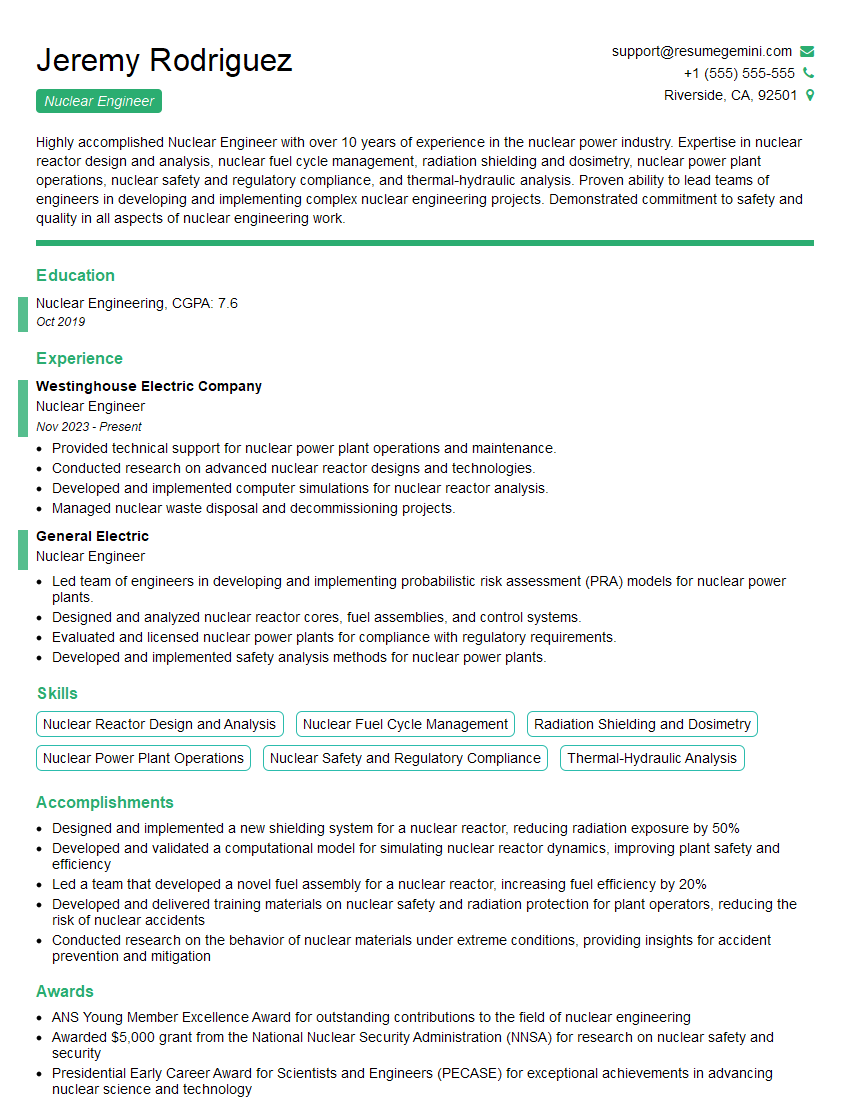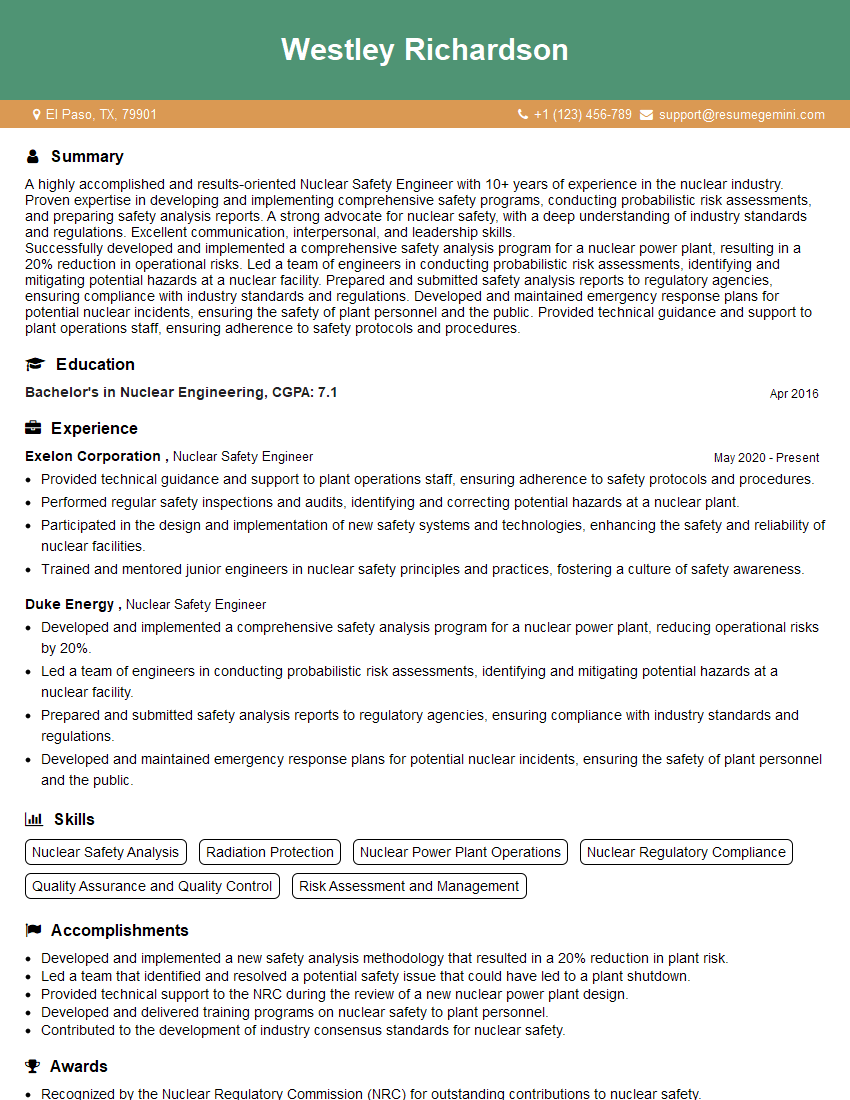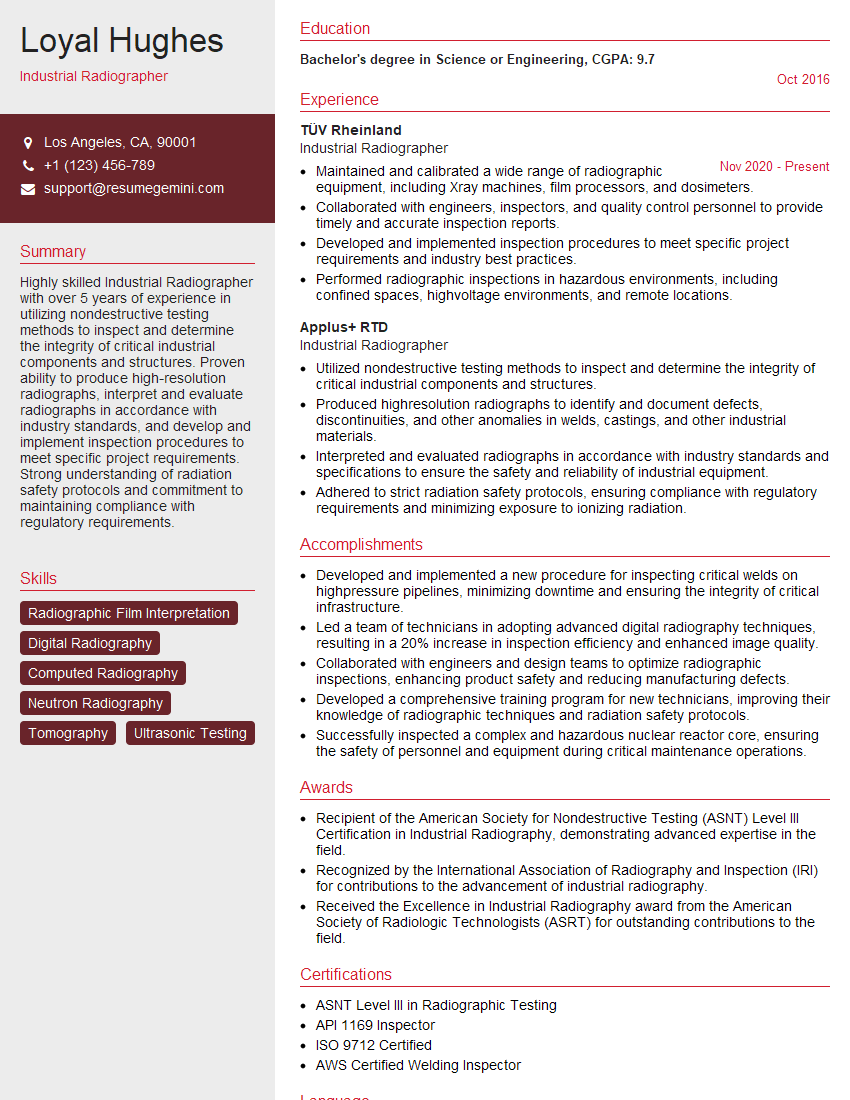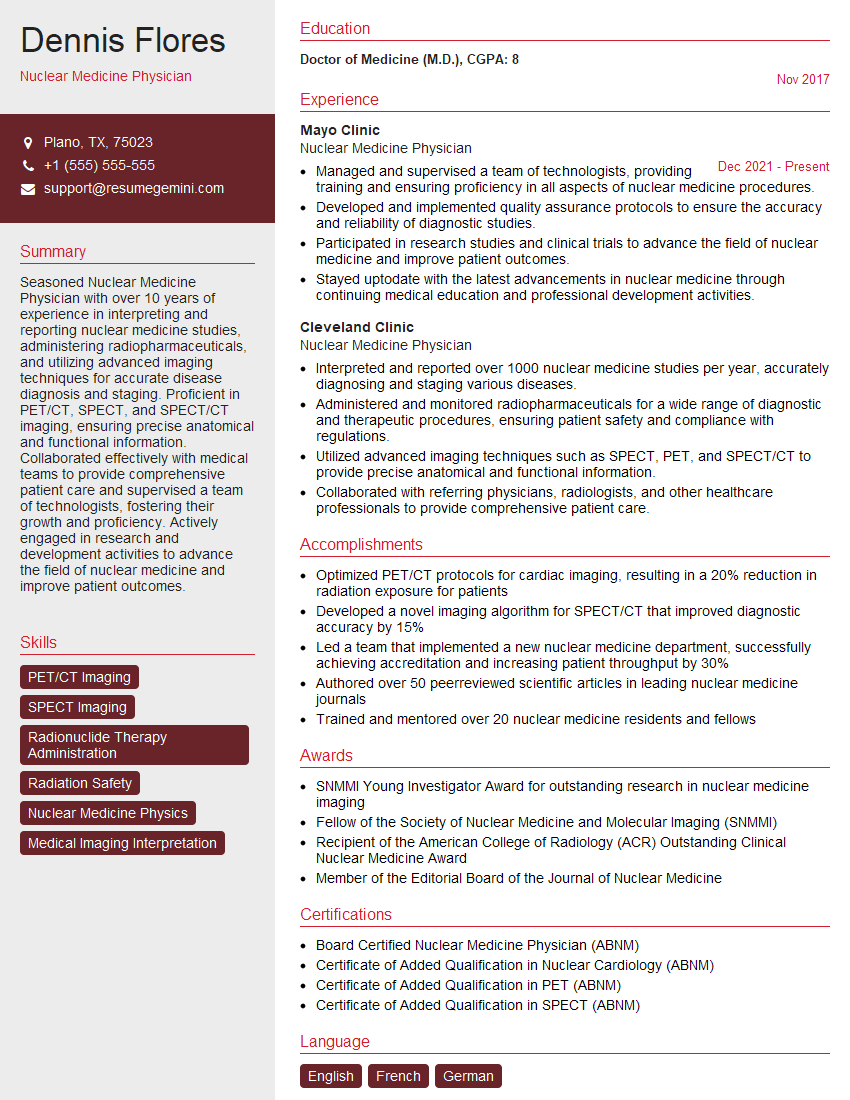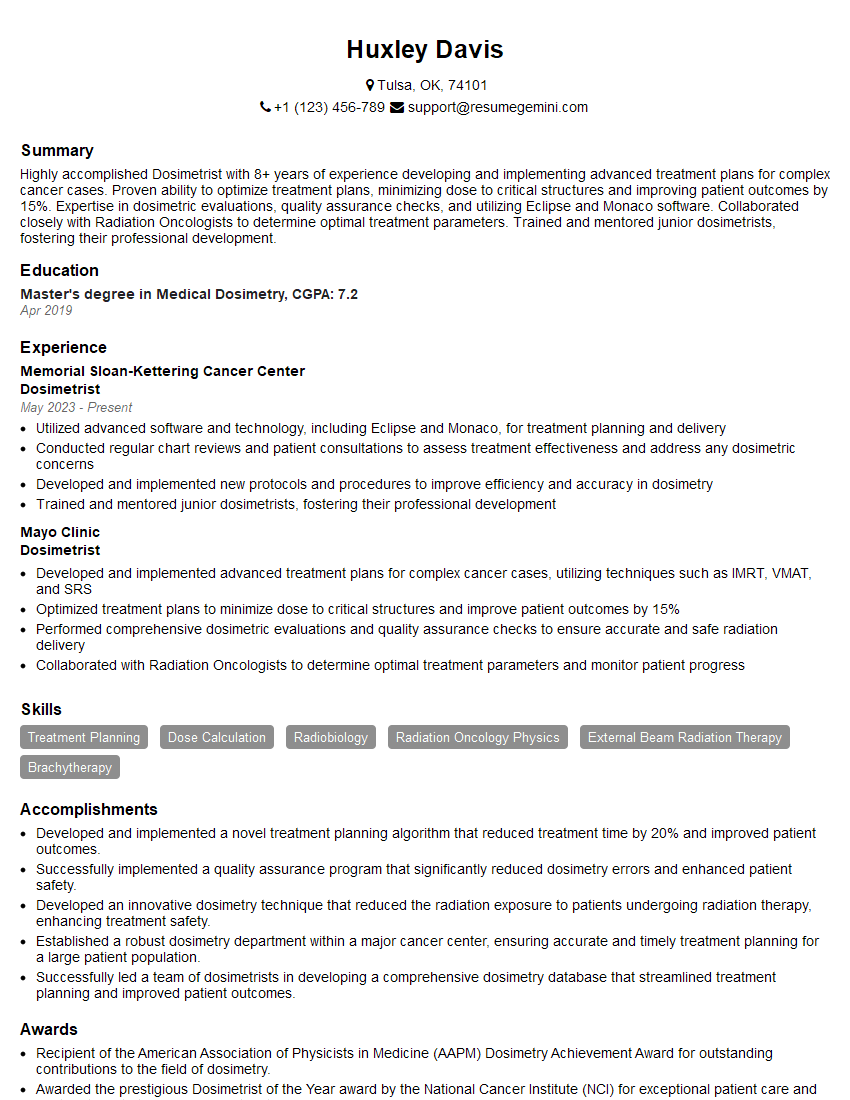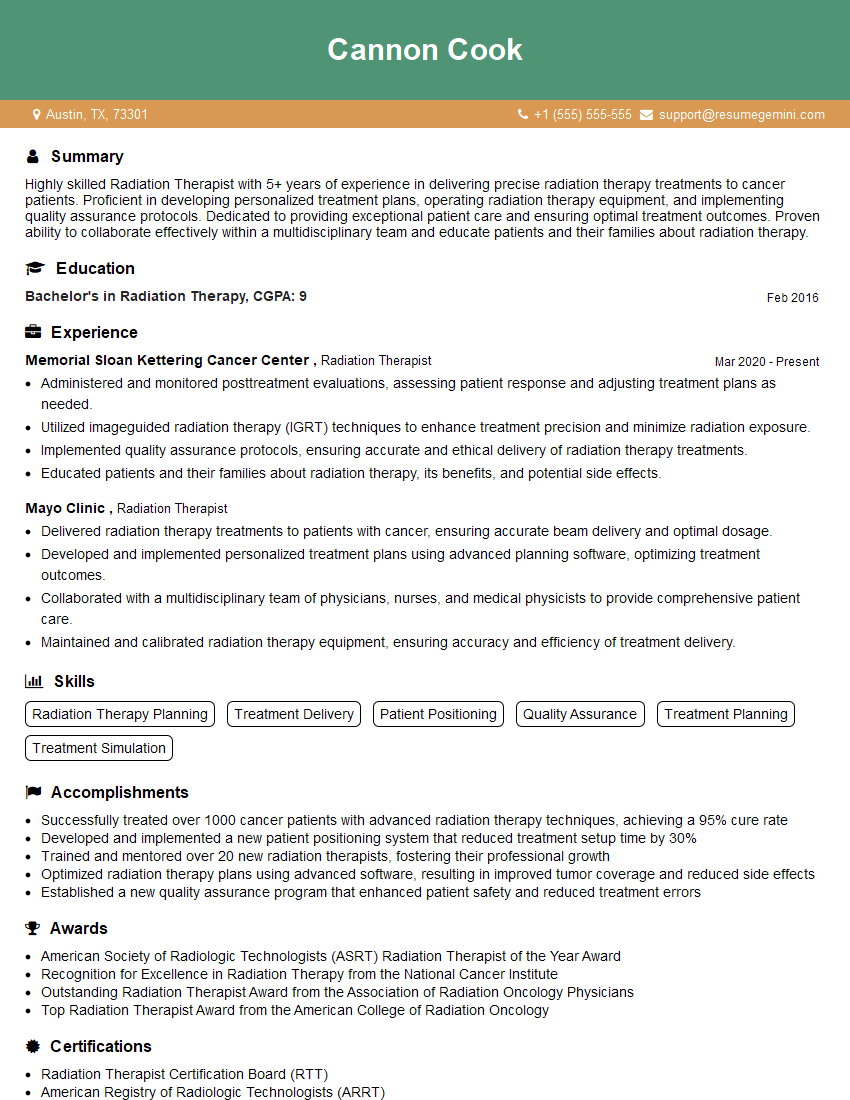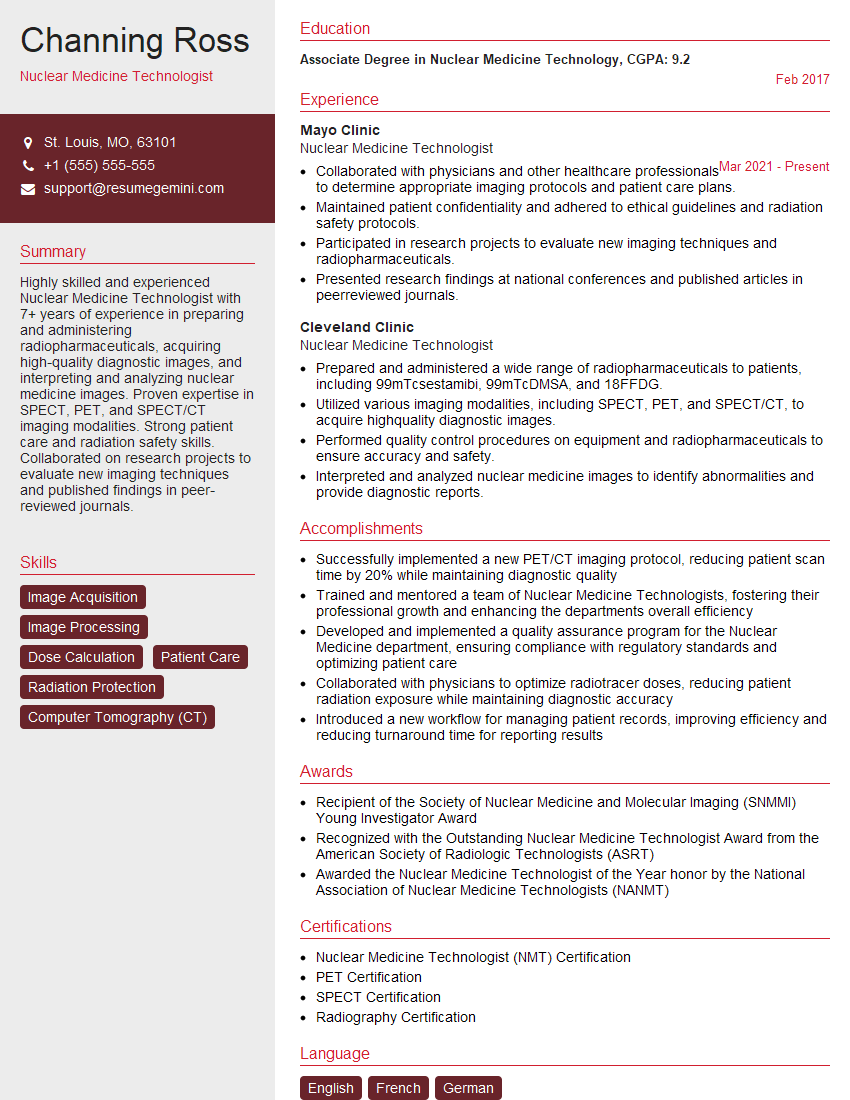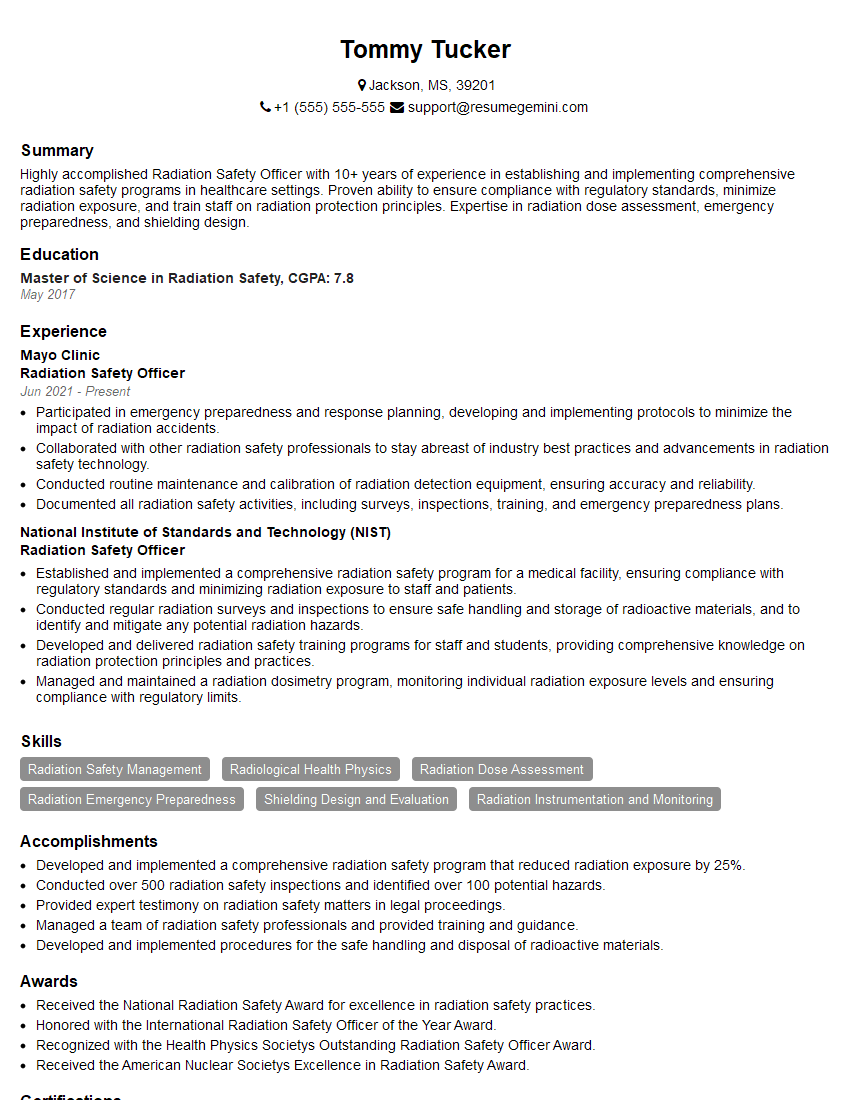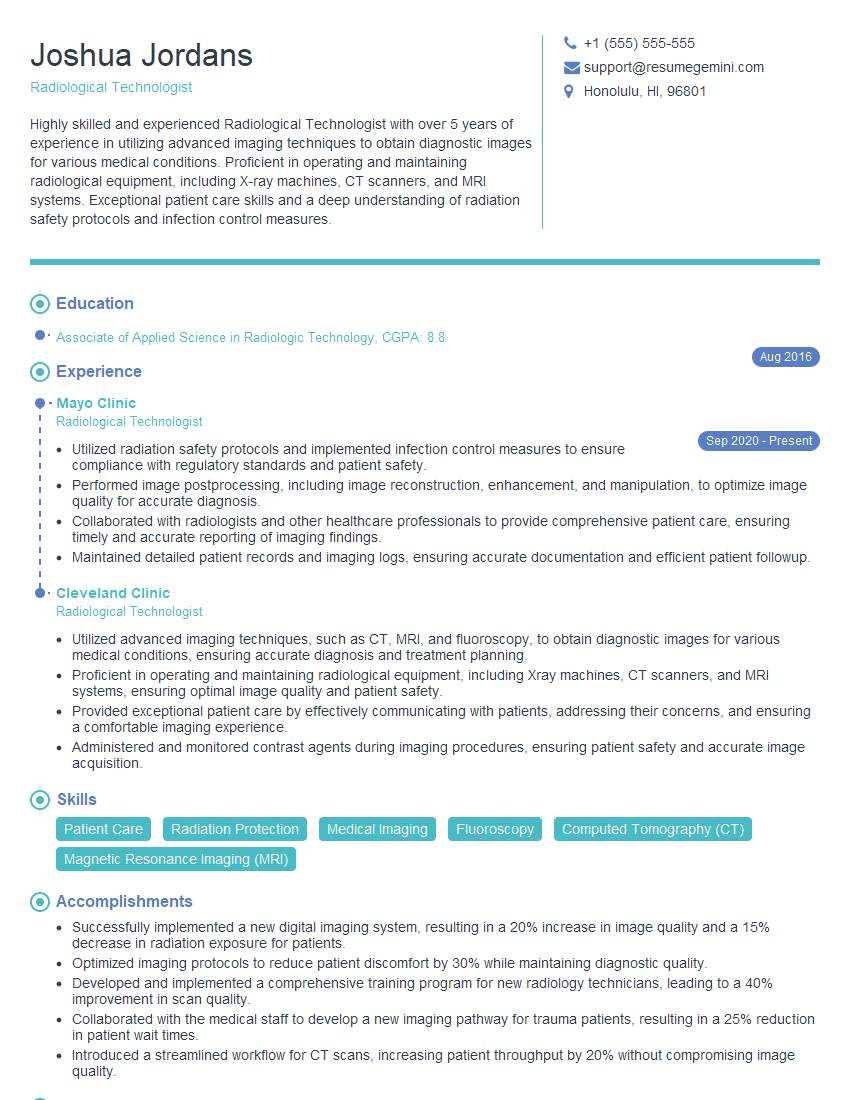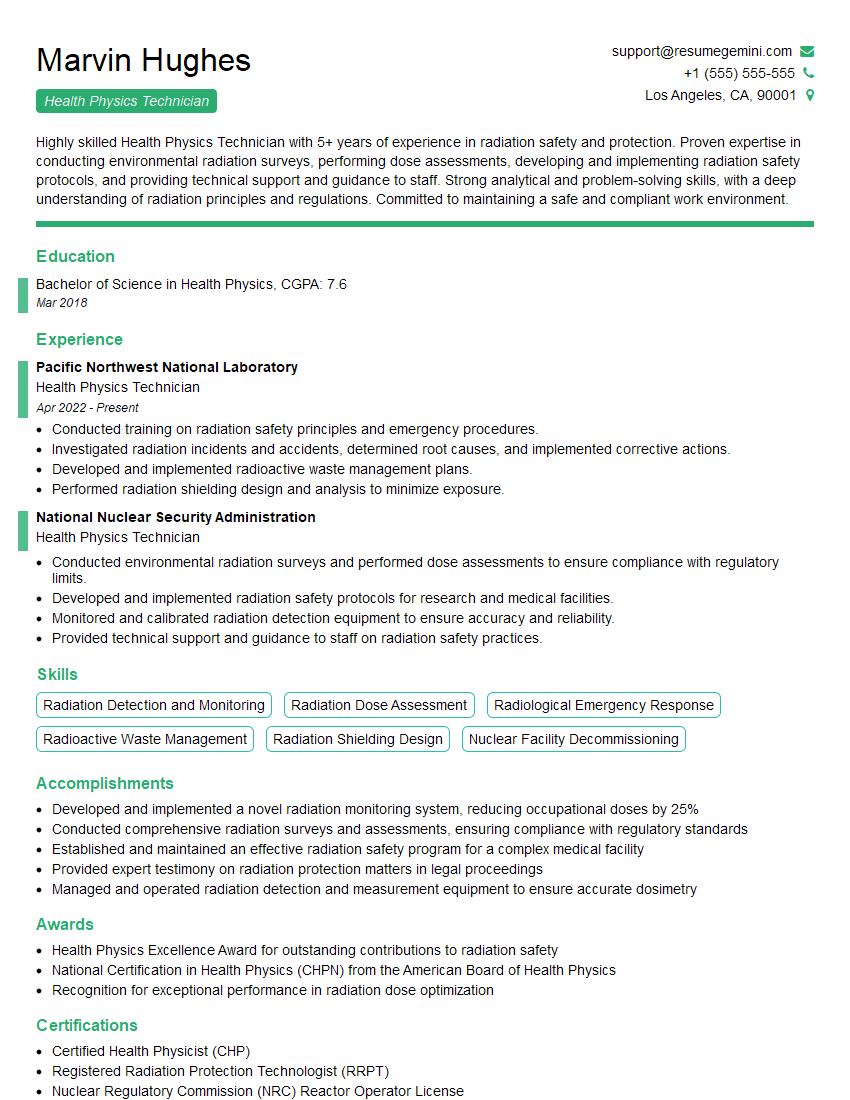Feeling uncertain about what to expect in your upcoming interview? We’ve got you covered! This blog highlights the most important Radiation Protection Principles and Practices interview questions and provides actionable advice to help you stand out as the ideal candidate. Let’s pave the way for your success.
Questions Asked in Radiation Protection Principles and Practices Interview
Q 1. Explain the ALARA principle and its practical application.
The ALARA principle, short for “As Low As Reasonably Achievable,” is a fundamental tenet of radiation protection. It emphasizes that radiation exposure should be kept as low as possible, taking into account economic and societal factors. It’s not about eliminating all radiation, but rather finding a balance between minimizing risk and the practicality of implementing protective measures.
Practical Application: Imagine a nuclear power plant. While complete elimination of radiation exposure is impossible, ALARA guides decisions like optimizing plant design for radiation shielding, implementing robust safety protocols for workers, and choosing monitoring equipment that delivers the highest accuracy with the lowest radiation exposure to the operator during maintenance. A hospital using X-ray machines will use the ALARA principle to minimize patient exposure by employing optimized techniques, using appropriate shielding, and ensuring the machine is calibrated correctly.
Q 2. Describe different types of ionizing radiation and their relative biological effectiveness.
Ionizing radiation is energy that can remove electrons from atoms, creating ions. Different types have varying biological effects. Relative Biological Effectiveness (RBE) compares the biological damage caused by different types of radiation relative to a standard, usually X-rays or gamma rays.
- Alpha particles: Heavily ionizing, high RBE, short range. Dangerous if ingested or inhaled, but easily shielded by skin or paper.
- Beta particles: Less ionizing than alpha, moderate RBE, moderate range. Can penetrate skin but stopped by thin metal shielding.
- Gamma rays: Electromagnetic radiation, low ionizing power, lower RBE, long range. Requires thick shielding (lead, concrete).
- X-rays: Electromagnetic radiation, similar to gamma rays but lower energy, less penetrating. Shielding requirements are similar but often less extreme.
- Neutrons: Uncharged particles, high RBE, range varies greatly depending on energy. Require specialized shielding (boron, water, concrete).
The RBE varies depending on the type of radiation and the biological system being affected. While alpha particles have a high RBE, their short range limits their effect unless internally deposited.
Q 3. What are the primary methods used for personnel radiation monitoring?
Personnel radiation monitoring aims to measure the dose received by individuals working with ionizing radiation. Common methods include:
- Film badges: A photographic film enclosed in a holder, sensitive to different types of radiation. Provides a cumulative dose reading after processing.
- Thermoluminescent dosimeters (TLDs): Crystals that store energy when exposed to radiation. Heating releases the stored energy as light, proportional to the radiation dose.
- Optically stimulated luminescence dosimeters (OSLDs): Similar to TLDs, but stimulated by light instead of heat, offering greater accuracy and reusability.
- Electronic personal dosimeters (EPDs): Real-time dose measurement devices that provide immediate feedback, often with audible or visual alerts when exceeding pre-set dose limits.
The choice of monitoring method depends on the type and level of radiation encountered, regulatory requirements, and practical considerations such as cost and ease of use.
Q 4. Explain the concept of half-life and its significance in radiation protection.
Half-life is the time it takes for half of the radioactive atoms in a sample to decay. This is a crucial concept in radiation protection because it dictates how long a radioactive source remains hazardous.
Significance: A short half-life means rapid decay and reduces the risk more quickly. Long half-life materials require longer storage and management periods due to their prolonged radioactivity. For example, Iodine-131, used in some medical treatments, has a short half-life (8 days), allowing the patient to quickly clear the radioactive material. Conversely, Strontium-90, a byproduct of nuclear fission, has a long half-life (28.8 years), requiring careful long-term disposal.
Understanding half-life is essential for determining storage times, shielding requirements, and the long-term environmental impact of radioactive materials.
Q 5. Describe different radiation shielding materials and their effectiveness against various types of radiation.
The effectiveness of shielding materials depends on the type of radiation being shielded.
- Lead: Excellent for gamma rays and X-rays due to its high density. Less effective against neutrons.
- Concrete: Cost-effective for shielding gamma rays and neutrons (especially with added boron). The thickness required depends on the radiation energy.
- Water: Effective for neutron shielding due to hydrogen’s high neutron absorption capacity. Also used for spent nuclear fuel pool storage.
- Steel: Offers good shielding against beta particles and low-energy gamma rays. Often used in combination with other materials.
- Boron: Very effective in absorbing neutrons. Often added to concrete or other materials to improve neutron shielding.
The choice of shielding material and its thickness are determined by the type, energy, and intensity of the radiation source, ensuring adequate protection for personnel and the environment.
Q 6. What are the regulatory requirements for handling radioactive materials in your country/region?
(This answer will vary depending on the country/region. The following is a general example and should be replaced with specific regulations for a particular location.)
In many countries, regulatory bodies like the Nuclear Regulatory Commission (NRC – example from the US, replace with your region’s relevant authority) oversee the handling of radioactive materials. Regulations typically cover:
- Licensing: Individuals and organizations must obtain licenses to possess and use radioactive materials.
- Safety standards: Stringent rules govern the design, operation, and maintenance of facilities handling radioactive materials, including worker safety protocols, emergency procedures, and waste management.
- Transportation: Strict regulations dictate the packaging, labeling, and transportation of radioactive materials to minimize risk during transit.
- Waste disposal: Safe disposal methods are mandated to prevent environmental contamination, often involving specialized disposal facilities.
- Monitoring and reporting: Regular monitoring of radiation levels and detailed reporting of incidents and exposures are required.
Penalties for non-compliance can be severe, including hefty fines and legal action. It is crucial to consult the relevant regulatory authorities for the most up-to-date and specific information.
Q 7. How do you calculate radiation exposure using dosimetry data?
Calculating radiation exposure from dosimetry data involves several steps and depends on the type of dosimeter used.
For example, with a TLD:
- Obtain TLD reading: The TLD is read using a TLD reader, which provides a reading in terms of the radiation absorbed dose (usually in Gray (Gy) or rad).
- Convert to equivalent dose: Multiply the absorbed dose by a radiation weighting factor (wR) to account for the type of radiation. This converts the absorbed dose to equivalent dose (Sieverts (Sv) or rem).
- Consider tissue weighting factors: For internal radiation, further adjustments are made using tissue weighting factors (wT) which account for the relative radiosensitivity of different organs and tissues to arrive at an effective dose.
- Apply calibration factors: Account for any calibration factors provided by the dosimetry service.
The formula for effective dose is: Effective Dose (Sv) = Σ [wT x wR x Absorbed Dose (Gy)]
For electronic dosimeters (EPDs): The dose is often directly displayed in the appropriate units (Sv or mSv). However, ensure proper calibration and proper operation of the EPD to ensure accuracy.
Always consult the dosimetry service’s guidelines for detailed procedures and interpretation of the data. It’s crucial to maintain accurate records for regulatory compliance and radiation safety.
Q 8. Explain the difference between internal and external radiation exposure.
The key difference between internal and external radiation exposure lies in where the radioactive source is located relative to the body. External exposure occurs when a radioactive source is outside the body, and radiation emitted from the source interacts with the body. Think of a medical X-ray; the X-ray machine is external, and its radiation passes through your body. The damage is primarily limited to the tissues exposed to the radiation beam. Internal exposure, on the other hand, happens when radioactive material is ingested, inhaled, or absorbed into the body. This means the source of radiation is inside the body, emitting radiation directly into surrounding tissues. An example would be radon gas inhalation, where the radioactive radon decays within the lungs, causing localized damage. Internal exposure is generally considered more hazardous than external exposure because the radiation is continuously emitted within the body, leading to prolonged damage and potential systemic effects.
Q 9. What are the common sources of background radiation?
Background radiation is the ionizing radiation present in our environment from natural and man-made sources. Natural sources include cosmic rays from space (which increase with altitude), terrestrial radiation from naturally occurring radioactive materials in the soil and rocks (like uranium, thorium, and potassium-40), and internal radiation from the naturally occurring radioactive isotopes within our own bodies (such as potassium-40 and carbon-14). Man-made sources contribute a smaller portion, and these include medical procedures (X-rays, CT scans, nuclear medicine), industrial activities (e.g., nuclear power plants – but these are highly regulated and contribute minimal background radiation in most places), and fallout from past nuclear weapons testing (though this contribution has significantly decreased over time). The amount of background radiation varies geographically. For instance, areas with high concentrations of uranium in the soil will have higher levels of background radiation than areas with lower concentrations.
Q 10. Describe the different types of radiation detectors and their applications.
Several types of radiation detectors are used in radiation protection, each with specific applications. Geiger-Müller counters are widely used for detecting beta and gamma radiation. They’re relatively inexpensive, portable, and give a quick indication of radiation levels. They are often used in environmental monitoring and emergency response. Scintillation detectors, using scintillating crystals, are more sensitive and can detect a broader range of radiation types including alpha, beta, and gamma. These are often used in nuclear medicine and research applications for precise measurements. Ionization chambers are used for measuring higher radiation levels and are often employed in radiation therapy and industrial settings. Thermoluminescent dosimeters (TLDs) are passive detectors that measure cumulative radiation exposure over a period of time. They are commonly used for personal dosimetry, providing a record of an individual’s radiation dose. The choice of detector depends on the type of radiation being measured, the required sensitivity, and the specific application.
Q 11. What are the biological effects of ionizing radiation on human cells?
Ionizing radiation’s biological effects on human cells stem from its ability to ionize atoms and molecules within cells. This ionization can directly damage DNA, leading to mutations, cell death, or uncontrolled cell growth (cancer). The effects depend on several factors: the type of radiation (alpha, beta, gamma, or neutron), the dose received, and the rate at which the dose is delivered. Direct effects involve direct damage to DNA from ionization. Indirect effects occur when radiation ionizes water molecules, creating free radicals that subsequently damage DNA. High doses of radiation can cause acute radiation sickness, characterized by nausea, vomiting, and potentially death. Lower doses, accumulated over time, increase the risk of long-term health effects such as cancer and genetic damage. The body has repair mechanisms for DNA damage, but these can be overwhelmed by high doses or prolonged exposure. This is why radiation protection principles emphasize minimizing exposure to ionizing radiation.
Q 12. Explain the concept of effective dose and equivalent dose.
Equivalent dose (measured in Sieverts, Sv) accounts for the different biological effectiveness of various types of ionizing radiation. Different types of radiation have different abilities to cause damage to biological tissues. A weighting factor is applied to the absorbed dose to account for this difference. For example, alpha particles are more damaging than beta particles, so they have a higher weighting factor. Effective dose (also measured in Sieverts, Sv) takes into account the equivalent dose to various organs and tissues, along with their relative sensitivity to radiation. It provides a more comprehensive measure of the overall risk of harm from radiation exposure. It is calculated by summing the weighted equivalent doses to different organs and tissues. Essentially, equivalent dose considers the type of radiation, while effective dose considers both the type of radiation and the sensitivity of different organs and tissues.
Q 13. How do you perform a radiation area survey?
A radiation area survey aims to identify and quantify radiation levels in a specific area. The process typically involves the following steps:
- Planning: Defining the area to be surveyed, the types of radiation to be measured, and the required level of accuracy.
- Instrument selection: Choosing appropriate radiation detectors based on the type of radiation and expected levels.
- Calibration: Ensuring that the radiation detection instruments are properly calibrated and functioning correctly.
- Measurement: Performing measurements at various locations within the defined area. It’s crucial to follow established protocols for measurement techniques, including instrument positioning, time of measurement and background subtraction.
- Data recording: Accurately recording the measured radiation levels, along with location and time of measurement.
- Analysis: Evaluating the measured data to determine whether radiation levels are within acceptable limits, using relevant regulations or guidelines.
- Reporting: Preparing a comprehensive report outlining the survey findings, conclusions, and recommendations.
Q 14. What are the emergency procedures in case of a radiation spill or accident?
Emergency procedures for radiation spills or accidents depend on the nature and scale of the incident. However, some general principles apply:
- Immediate actions: Evacuate the affected area and restrict access to prevent further exposure. Alert emergency responders and radiation protection specialists.
- Containment: If possible, contain the spill using appropriate materials and procedures.
- Decontamination: Decontaminate personnel and equipment using appropriate methods, which might include washing, special cleaning agents, or specialized equipment.
- Assessment: Conduct a thorough radiation survey to assess the extent of contamination.
- Remediation: Take steps to clean up and remediate the affected area.
- Medical attention: Provide immediate medical attention to those who may have been exposed.
Q 15. What are the safety precautions for working with sealed and unsealed radioactive sources?
Working with radioactive sources, whether sealed or unsealed, demands rigorous safety precautions. The key difference lies in the potential for spread of radioactive material. Sealed sources, like those in medical equipment or industrial gauges, contain the radioactive material within a robust, leak-proof container. Unsealed sources, often used in research labs or medical procedures, present a greater risk because the radioactive material can be dispersed into the environment.
- Sealed Sources: Safety precautions primarily focus on preventing physical damage to the source leading to leakage. This includes using appropriate handling tools, avoiding dropping or impacting the source, and following strict storage and transportation protocols. Regular leak testing is crucial. For instance, a damaged industrial gauge containing a sealed source needs immediate isolation and reporting to the relevant authorities.
- Unsealed Sources: Working with unsealed sources demands even more stringent controls. These include performing all operations within designated areas with specialized ventilation, using personal protective equipment (PPE) such as gloves, lab coats, and respiratory protection, employing containment techniques to minimize spills or airborne dispersion, and meticulous monitoring of work surfaces and personnel. For example, preparing radioisotope solutions for medical imaging requires handling in a fume hood with constant monitoring for contamination.
In both cases, adherence to ALARA (As Low As Reasonably Achievable) principles is paramount. This means minimizing radiation exposure through optimization of techniques and engineering controls. Proper documentation and training are essential aspects of safe work practices.
Career Expert Tips:
- Ace those interviews! Prepare effectively by reviewing the Top 50 Most Common Interview Questions on ResumeGemini.
- Navigate your job search with confidence! Explore a wide range of Career Tips on ResumeGemini. Learn about common challenges and recommendations to overcome them.
- Craft the perfect resume! Master the Art of Resume Writing with ResumeGemini’s guide. Showcase your unique qualifications and achievements effectively.
- Don’t miss out on holiday savings! Build your dream resume with ResumeGemini’s ATS optimized templates.
Q 16. Describe the process of radioactive waste management.
Radioactive waste management is a multi-stage process aimed at minimizing environmental impact and protecting public health. The process begins with segregation of waste according to its radioactivity level (low, intermediate, or high). This segregation is critical for selecting appropriate disposal methods.
- Low-level waste (LLW): This typically includes items contaminated with small amounts of radioactivity. Treatment might involve compaction, incineration, or solidification before disposal in designated landfills.
- Intermediate-level waste (ILW): This has higher radioactivity levels and may require more extensive treatment, such as cementation or vitrification (embedding in glass), before long-term storage in engineered facilities.
- High-level waste (HLW): This includes spent nuclear fuel and highly radioactive liquid waste from reprocessing. HLW requires long-term geological disposal in deep underground repositories after extensive processing to reduce volume and enhance stability. This is the most challenging aspect of waste management, involving significant technical and societal considerations.
Throughout the entire process, stringent regulatory oversight ensures adherence to safety standards. Careful monitoring of environmental impact is crucial to prevent release of radioactivity into the environment.
Q 17. What are the different types of radiation monitoring instruments and their limitations?
Various radiation monitoring instruments are used depending on the type and energy of the radiation and the application. Common instruments include:
- Geiger-Müller counters: These are simple, portable detectors useful for detecting beta and gamma radiation. However, they lack energy discrimination and can be inaccurate at high radiation levels.
- Scintillation detectors: These offer better energy resolution and can measure various radiation types, including alpha, beta, and gamma. They are commonly used for precise measurements and spectroscopy but are often more complex and expensive.
- Ionization chambers: These are used for high-dose-rate measurements and are more robust than Geiger-Müller counters. They are, however, less sensitive for low-level radiation.
- Dosimeters (personal and environmental): These measure cumulative radiation exposure, either for individuals (personal dosimeters, like thermoluminescent dosimeters (TLDs) or optically stimulated luminescence (OSL) dosimeters) or for the environment (environmental dosimeters).
Limitations: Every instrument has limitations. Geiger counters are not precise for dose rate measurements. Scintillation detectors are more complex to operate and calibrate. Some instruments are sensitive to specific radiation types only. Proper calibration, use, and understanding of instrument limitations are vital for accurate radiation monitoring.
Q 18. Explain the importance of radiation safety training and education.
Radiation safety training and education are paramount for minimizing risks and ensuring compliance with regulations. Comprehensive training equips individuals with the knowledge and skills to handle radioactive materials safely and protect themselves and the public.
- Theoretical knowledge: Training must cover the basics of radiation physics, the effects of radiation on living organisms, radiation protection principles, relevant regulations, and emergency procedures.
- Practical skills: Hands-on training on the use of radiation monitoring instruments, safe handling procedures for radioactive materials, contamination control techniques, and emergency response protocols are essential.
- Continuing education: Regular updates are needed to reflect changes in regulations, technology, and best practices.
Effective training reduces accidents, minimizes exposure, and instills a strong safety culture. A well-trained workforce is better equipped to identify and mitigate potential hazards, resulting in a safer work environment and greater public protection.
Q 19. Describe the different regulatory agencies involved in radiation protection.
Regulatory agencies play a vital role in ensuring radiation safety. Specific agencies vary by country, but generally, these include:
- National Nuclear Regulatory Authority/Commission: This is the primary agency responsible for overseeing nuclear activities and enforcing radiation protection regulations. They issue licenses, conduct inspections, and investigate incidents.
- Environmental Protection Agencies: These agencies are involved in managing radioactive waste disposal and environmental monitoring to ensure public safety.
- Health Departments/Ministries: These agencies play a role in ensuring radiation protection in medical settings and in public health surveillance.
International organizations, like the International Atomic Energy Agency (IAEA), also provide guidance and standards for radiation protection on a global scale.
Q 20. How do you ensure compliance with radiation safety regulations?
Ensuring compliance with radiation safety regulations requires a multi-pronged approach.
- Establish a robust radiation safety program: This includes developing and implementing written procedures, designating radiation safety officers, conducting regular monitoring, and maintaining detailed records.
- Regular training and education: Ongoing training ensures that staff are aware of regulations and procedures.
- Effective quality control: Calibration of instruments and regular checks of equipment ensure accuracy and reliability of measurements.
- Internal audits and self-assessments: Regularly reviewing compliance measures helps to identify areas for improvement.
- Accurate record-keeping: Maintaining detailed records of radiation levels, waste disposal, and personnel dosimetry is crucial for demonstrating compliance.
- Cooperation with regulatory agencies: Open communication and timely reporting of any incidents or anomalies are essential for maintaining compliance.
A proactive and transparent approach to radiation safety fosters a culture of compliance and minimizes risks.
Q 21. Explain the concept of time, distance, and shielding in radiation protection.
The principles of Time, Distance, and Shielding (TDS) are fundamental to radiation protection. They provide a simple yet effective strategy for minimizing radiation exposure.
- Time: Reducing the time spent near a radiation source directly reduces the cumulative dose. The dose is proportional to the time of exposure. Imagine you’re working near an X-ray machine; minimizing the time spent in the vicinity is crucial.
- Distance: Increasing the distance from a radiation source significantly reduces exposure. Radiation intensity decreases rapidly with increasing distance (inverse square law). This means doubling the distance reduces the exposure to one-fourth. Staying further away from a radioactive source reduces risk considerably.
- Shielding: Interposing a shielding material between the radiation source and the individual absorbs radiation. The type and thickness of the shielding depend on the type and energy of the radiation. For instance, lead shielding is effective against gamma rays, while concrete is used for shielding against neutrons.
By carefully managing these three factors, radiation exposure can be effectively minimized, thereby enhancing safety and reducing health risks. Implementing TDS is often the first and simplest step in controlling radiation exposure in any application.
Q 22. How do you interpret a radiation survey report?
Interpreting a radiation survey report involves a systematic approach to understand the radiation levels detected in a specific area. It’s not simply reading the numbers; it’s about understanding the context and implications. First, I would check the survey methodology: what type of instrument was used (e.g., Geiger-Müller counter, scintillation detector), what units are reported (e.g., µSv/h, CPM, counts/minute), and the date and time of the measurement. The report should specify the location of each measurement, and any potential sources of radiation should be identified and considered.
Next, I would compare the measured radiation levels to the relevant regulatory limits and background radiation levels for the area. Exceeding regulatory limits indicates a potential hazard requiring corrective action. A comparison to background radiation helps determine if the detected levels are significantly elevated or within normal expectations. For example, an area near a nuclear power plant will naturally have higher background radiation than a rural area. I’d also look for any trends or patterns in the data – consistent high readings in a specific area might indicate a persistent contamination source. Finally, I would assess the overall significance of the findings and recommend any necessary actions, such as further investigation, decontamination, or changes to work procedures.
For instance, if a survey shows consistently high beta radiation readings in a specific lab bench, it suggests potential contamination, necessitating immediate investigation and decontamination procedures. Conversely, if the readings are within normal background levels, it indicates the area is safe for the intended use.
Q 23. What are the different methods of contamination control?
Contamination control involves preventing the spread of radioactive materials and minimizing their impact on the environment and personnel. Methods can be broadly categorized into administrative, engineering, and procedural controls.
- Administrative Controls focus on planning and management. This includes establishing radiation safety programs, implementing training programs for personnel, developing written procedures for handling radioactive materials, and conducting regular radiation surveys.
- Engineering Controls involve physical modifications to reduce exposure. Examples include using shielded containers for radioactive materials, implementing ventilation systems to reduce airborne contamination, installing physical barriers to limit the spread of contamination, and using remote handling devices to minimize direct contact.
- Procedural Controls address the day-to-day work practices. These include establishing strict contamination control areas, using appropriate personal protective equipment (PPE) like respirators, gloves, and protective clothing, employing proper decontamination procedures, implementing waste segregation and disposal protocols, and adhering to strict cleanliness standards.
For example, in a nuclear medicine lab, engineering controls might include a fume hood for handling volatile radioactive materials. Procedural controls would include a step-by-step decontamination procedure for spills, and administrative controls would involve regular radiation safety training for staff and a robust waste management program.
Q 24. Describe your experience with radiation safety program development and implementation.
I have extensive experience in developing and implementing radiation safety programs across diverse settings, from research laboratories to industrial facilities. My approach begins with a thorough risk assessment to identify potential hazards and vulnerabilities. This includes evaluating the types and quantities of radioactive materials used, the work practices involved, and the potential for exposure pathways. Based on this assessment, I develop a comprehensive radiation safety program that aligns with regulatory requirements and industry best practices.
The program typically includes:
- Written procedures for handling radioactive materials, including spill response and emergency procedures.
- Training programs tailored to the specific needs of different personnel groups.
- Radiation monitoring and survey programs to ensure compliance with regulatory limits.
- Waste management protocols for safe and compliant disposal of radioactive waste.
- Emergency response plans to address potential radiation incidents.
In implementing these programs, I emphasize proactive engagement with personnel, emphasizing the importance of safety and fostering a culture of continuous improvement through regular audits and feedback mechanisms. One successful program I developed involved a significant reduction in radiation exposure levels in a research facility by implementing a new ventilation system and revising handling procedures for a particular isotope.
Q 25. Explain the concept of criticality safety.
Criticality safety focuses on preventing accidental nuclear chain reactions (criticality) that can release significant amounts of radiation. This is particularly relevant when working with fissile materials – materials capable of sustaining a chain reaction – such as uranium and plutonium. Criticality accidents can lead to severe radiation exposures and devastating consequences.
Preventing criticality involves understanding the factors that influence nuclear chain reactions: the amount and concentration of fissile material, its geometry (shape and size), the presence of neutron moderators (slowing down neutrons), and neutron reflectors (reflecting neutrons back into the fissile material). Safety measures are designed to prevent any combination of these factors that could lead to a criticality event.
These measures include:
- Administrative controls: Strict procedures for handling fissile materials, including limits on quantities and precise work instructions.
- Engineering controls: Designing facilities and equipment to minimize the risk of criticality, such as using subcritical geometries, neutron absorbers, and criticality alarms.
- Procedural controls: Implementing detailed procedures for all operations involving fissile materials, including the use of appropriate instrumentation and regular monitoring.
A classic example of criticality safety is the use of neutron absorbers, like boron, in the design of nuclear reactors and storage facilities for fissile materials. These absorbers reduce the probability of a chain reaction.
Q 26. How do you assess the risks associated with radiation exposure?
Assessing radiation exposure risks involves determining the probability and severity of harmful effects resulting from radiation exposure. This usually involves a multi-step process.
1. Identify the radiation source: Determine the type and quantity of radiation emitted (e.g., alpha, beta, gamma, neutron), its energy, and the exposure pathway (external exposure, internal exposure via inhalation or ingestion).
2. Estimate the dose: Calculate the absorbed dose (measured in Gray or rad) and equivalent dose (measured in Sievert or rem) using appropriate dosimetry techniques. For external exposure, this may involve using personal dosimeters or area monitoring instruments. For internal exposure, it may require bioassay measurements of radioactive materials in the body.
3. Assess the risks: Evaluate the potential health effects based on the estimated dose and the radiosensitivity of the exposed individual or population. This involves considering factors such as age, health status, and the duration of exposure. This may utilize dose-response relationships from epidemiological studies and other scientific literature.
4. Implement risk management strategies: Develop and implement measures to reduce or eliminate the identified risks, such as optimizing shielding, reducing exposure time, increasing distance from the source (ALARA principle), or implementing better work practices. This step is crucial in minimizing the chances of potential harm.
For instance, assessing the risk of radiation exposure to workers at a nuclear power plant involves calculating their dose from different radiation sources (reactor, spent fuel pools, etc.), comparing these doses to regulatory limits, and implementing ALARA strategies such as optimized shielding and regular monitoring. This allows for a proactive approach to maintain safety within the facility.
Q 27. What are the ethical considerations in radiation protection?
Ethical considerations in radiation protection are paramount, centered around the fundamental principle of ‘justification,’ ‘optimization,’ and ‘limitation of individual doses.’
Justification means that any radiation exposure must have a clear benefit that outweighs the associated risks. A medical X-ray, for example, must be justified by the diagnostic benefits to the patient. Unnecessary exposures are unethical.
Optimization means minimizing radiation exposure to the lowest reasonably achievable level, consistent with the overall goals of the activity – the ALARA principle. This involves implementing practical measures to reduce exposure, without compromising the purpose of the activity.
Limitation of individual doses involves setting dose limits to prevent excessive exposures to individuals. These limits are based on scientific understanding of the health effects of radiation and aim to prevent deterministic effects (effects that increase in severity with dose) and limit the risk of stochastic effects (effects that occur randomly, like cancer). The ethical considerations involve ensuring these limits are set appropriately and are effectively enforced.
Beyond these core principles, ethical considerations encompass transparency, informed consent (particularly in medical applications), equity of access to radiation protection measures, and addressing potential environmental impacts of radiation practices. For example, ensuring that patients undergoing radiation therapy receive all necessary information before the procedure and have a clear understanding of potential risks aligns with ethical obligations.
Q 28. Describe your experience with incident investigation and reporting related to radiation safety.
I have significant experience investigating and reporting radiation safety incidents. My approach is systematic and thorough, following established protocols and regulatory guidelines. The investigation process usually involves:
- Immediate Actions: Prioritizing the safety of personnel, securing the area, and implementing emergency procedures as needed.
- Data Collection: Gathering information about the incident, including witness statements, radiation monitoring data, equipment records, and relevant documentation.
- Analysis: Determining the root cause(s) of the incident, identifying contributing factors, and assessing the severity of the radiation exposure (if any).
- Corrective Actions: Developing and implementing recommendations to prevent similar incidents from occurring in the future.
- Reporting: Preparing a detailed report summarizing the findings, conclusions, and corrective actions, to be submitted to regulatory authorities and relevant stakeholders.
In one instance, I investigated a spill of a radioactive liquid in a research lab. Through a thorough investigation, we identified a faulty valve as the root cause and implemented a comprehensive review of all equipment, leading to the replacement of aging equipment and improved training protocols to prevent future spills. Detailed incident reports ensured transparency and aided in the implementation of corrective actions, demonstrating accountability and promoting continuous improvement in safety practices.
Key Topics to Learn for Radiation Protection Principles and Practices Interview
- Radiation Sources and Types: Understanding the different types of ionizing radiation (alpha, beta, gamma, X-rays, neutrons), their properties, and common sources.
- Basic Radiation Physics: Grasping fundamental concepts like half-life, activity, dose, and exposure. Be prepared to explain how these concepts relate to radiation protection.
- Radiation Protection Principles (ALARA): Demonstrate a thorough understanding of the ALARA principle (As Low As Reasonably Achievable) and its practical application in various settings.
- Shielding and Attenuation: Explain the principles of shielding against different types of radiation, including the use of various shielding materials and their effectiveness.
- Dosimetry and Instrumentation: Discuss different methods of radiation monitoring and dosimetry, including personal dosimeters and area monitoring instruments. Be prepared to explain how these devices work and interpret their readings.
- Radiation Safety Regulations and Standards: Familiarity with relevant national and international regulations and standards for radiation protection is crucial.
- Internal and External Exposure: Differentiate between internal and external radiation exposure, explaining the pathways of each and the associated risks.
- Risk Assessment and Management: Discuss the process of conducting radiation risk assessments and implementing appropriate safety measures to mitigate risks.
- Emergency Response Procedures: Understand the procedures for responding to radiation emergencies, including actions to take in case of spills or accidents.
- Practical Applications: Be ready to discuss real-world applications of radiation protection principles in various fields, such as medical imaging, nuclear power, and industrial radiography.
Next Steps
Mastering Radiation Protection Principles and Practices is essential for career advancement in this critical field. A strong understanding of these principles opens doors to diverse and rewarding opportunities. To maximize your job prospects, focus on creating an ATS-friendly resume that highlights your skills and experience effectively. ResumeGemini is a trusted resource that can help you build a professional and impactful resume. They provide examples of resumes tailored to Radiation Protection Principles and Practices, ensuring your application stands out from the competition. Take advantage of these resources to present yourself as the ideal candidate.
Explore more articles
Users Rating of Our Blogs
Share Your Experience
We value your feedback! Please rate our content and share your thoughts (optional).
What Readers Say About Our Blog
This was kind of a unique content I found around the specialized skills. Very helpful questions and good detailed answers.
Very Helpful blog, thank you Interviewgemini team.
